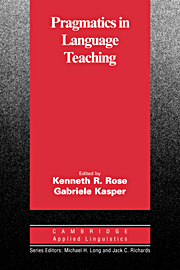Book contents
- Frontmatter
- Contents
- List of contributors
- Series editors' preface
- Preface
- Chapter 1 Pragmatics in language teaching
- I THEORETICAL AND EMPIRICAL BACKGROUND
- II ISSUES IN CLASSROOM-BASED LEARNING OF PRAGMATICS
- III THE EFFECTS OF INSTRUCTION IN PRAGMATICS
- Chapter 7 Acquiring French interactional norms through instruction
- Chapter 8 Inductive and deductive teaching of compliments and compliment responses
- Chapter 9 The role of input enhancement in developing pragmatic competence
- Chapter 10 Explicit and implicit teaching of pragmatic routines: Japanese sumimasen
- Chapter 11 Explicit instruction and JFL learner's use of interactional discourse markers
- IV THE ASSESSMENT OF PRAGMATIC ABILITY
- References
- Name index
- Subject index
Chapter 10 - Explicit and implicit teaching of pragmatic routines: Japanese sumimasen
Published online by Cambridge University Press: 05 October 2012
- Frontmatter
- Contents
- List of contributors
- Series editors' preface
- Preface
- Chapter 1 Pragmatics in language teaching
- I THEORETICAL AND EMPIRICAL BACKGROUND
- II ISSUES IN CLASSROOM-BASED LEARNING OF PRAGMATICS
- III THE EFFECTS OF INSTRUCTION IN PRAGMATICS
- Chapter 7 Acquiring French interactional norms through instruction
- Chapter 8 Inductive and deductive teaching of compliments and compliment responses
- Chapter 9 The role of input enhancement in developing pragmatic competence
- Chapter 10 Explicit and implicit teaching of pragmatic routines: Japanese sumimasen
- Chapter 11 Explicit instruction and JFL learner's use of interactional discourse markers
- IV THE ASSESSMENT OF PRAGMATIC ABILITY
- References
- Name index
- Subject index
Summary
Introduction
The majority of available research on the effects of instruction in pragmatics has focused on learners beyond a beginning level of proficiency (e.g., House & Kasper, 1981b; Billmyer, 1990a, 1990b; Olshtain & Cohen, 1990; Bouton, 1994a; Kubota, 1995; House, 1996), with only two studies to date examining whether pragmatics is teachable to beginners. Wildner-Bassett (1994) found that beginning learners of German improved considerably in their ability to use routine formulas after having received instruction. Tateyama, Kasper, Mui, Tay, and Thananart (1997) – which served as the pilot for the current study – examined the effects of instruction in pragmatics with beginning learners of Japanese at the University of Hawai'i. Students were divided into two groups, and received either implicit or explicit instruction in use of the Japanese pragmatic routine sumimasen and related expressions, which are commonly used for getting attention, apologizing, and expressing gratitude. Results showed that the explicit group outperformed the implicit group on a multiple-choice test as well as in role-plays rated by native speakers (NSs) of Japanese. The difference was especially notable in rather complicated situations, where the explicit group benefited more from the teacher's explanation of the use of the routine expressions under study. Although the treatment was provided only once during the 50-minute class period, the effectiveness of the instruction was obvious. In addition to role-plays and the multiple-choice test, students' verbal reports about their performance on role-plays provided valuable information about how they planned and executed speech acts in the target language.
- Type
- Chapter
- Information
- Pragmatics in Language Teaching , pp. 200 - 222Publisher: Cambridge University PressPrint publication year: 2001
- 62
- Cited by



